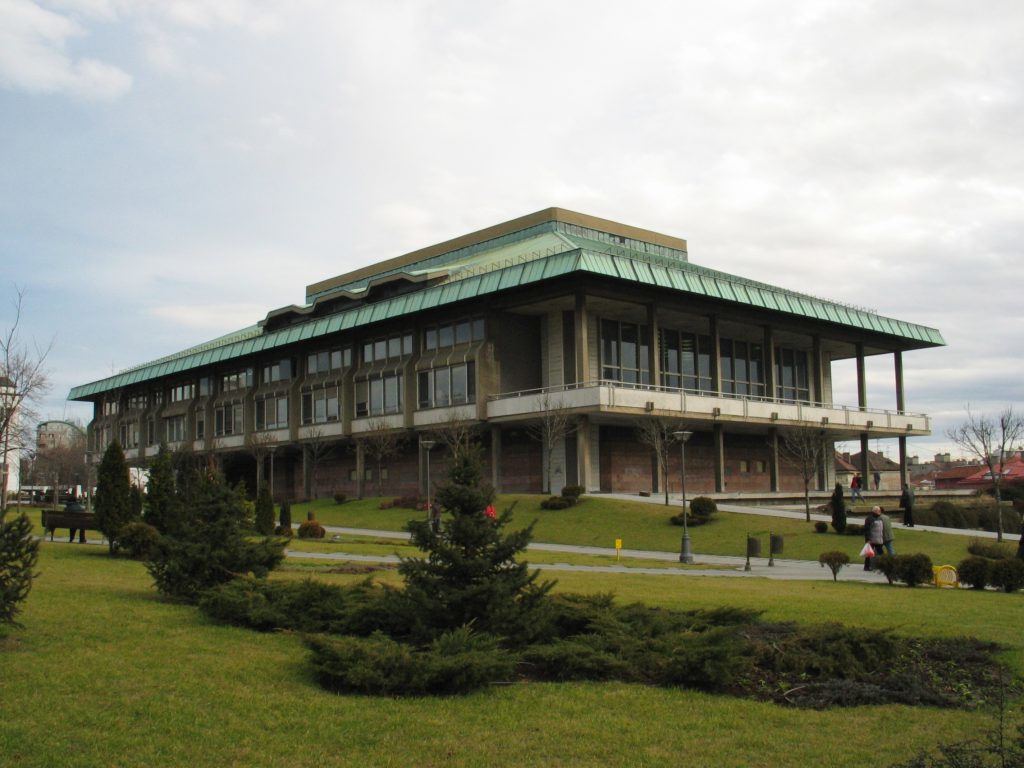The explosion of knowledge, accompanied by a proliferation of information contained in both printed and non-print library materials, has necessitated the adoption of automated methods and tools for processing, preserving and searching through library resources, along with the integration of library operations within library networks.
In 1985, the National Library of Serbia initiated a study on the “Implementation of Automated Data Processing Tools within the Library and Information Operations of both the National Library and the Library Network of Serbia”. However, this study was not completed. Starting from 1987, the library undertook the project titled The Science and Technology Information System of Yugoslavia (SNTIJ). It played an active role in devising and executing an integrated programme for library operations, based on a shared cataloguing approach within a centralised computer network. The sole format for data exchange and database structuring was UNIMARC, and a unified network of VAX-Digital computers constituted the backbone of the technical infrastructure.
In 1987, the library commenced cataloguing publications prior to their release, creating Cataloguing in Publication (CIP) records for monographs, which made up a significant part of the country’s entire publishing production.
In 1991, the National Library purchased a VAX-4000/300 computer, establishing a terminal network that formed the foundation of its computer infrastructure. The Library’s electronic catalogue was implemented in 1989. It encompassed all newly acquired library resources. Consequently, in June 1991, a decision was made to halt the production of printed catalogues.
The Science and Technology Information System of Yugoslavia (SNTIS) was adopted in 1991, paving the way for the development of a computerised library network as part of the system’s IT infrastructure.
The library took the lead in creating the “Plan for the Development of the Library Network of SNTIS” in 1992 and actively participated in its implementation in the subsequent years. During this period, substantial efforts were directed towards improving information technology resources. This involved enhancing the functions of the Centre for Scientific Information and Referral Services, which led the coordinated procurement system for foreign journals and databases (KOORDI). Additionally, a multimedia centre was established to facilitate online searches of databases stored on compact discs (CD-ROMs). By 1996, the library had interconnected its computer equipment through a local network, enabling internet access across all available devices. This initiative brought the National Library closer to realising the concept of a virtual library.
The Centre for Scientific Information and Referral Services, which functions as part of the Consortium of Serbian Libraries (KOBSON), enables online access to electronic journal databases. In Serbia, the majority of foreign sources of scientific information, whether in electronic or paper form, are procured through funding from the Ministry of Science, Technology and Development within the framework of a unified procurement programme. In modern librarianship, coordination often takes the form of consortia comprising similar library institutions. The primary goal of organising libraries in this manner is collaboration, aimed at achieving greater efficiency and more favourable procurement conditions. In the case of electronic resources, this primarily manifests in providing a greater number of better and more cost-effective services through a collective approach, enhancing information exchange and creating better conditions for usage monitoring and evaluation. The Consortium of Serbian Libraries for Unified Procurement (KOBSON) represents a new organisational form involving all libraries within scientific research institutions (universities, faculties and institutes). The National Library of Serbia serves as the representative for negotiations (with publishers and relevant ministries) and manages the entire system.
The objective of the Retrospective Conversion Project is to migrate data from traditional catalogues to electronic formats, thereby providing users with electronic access to information about the collections held by the Library. This initiative involves converting historical card and printed catalogues into an electronic database accessible online through the National Library of Serbia (NBS) website. Ultimately, this project aims to create a fully automated library catalogue accessible both on-site via library computers and remotely over the internet, enabling national and international users to access the Library’s complete holdings, totalling 5 million diverse units of materials in various formats and origins.
The inception of the Virtual Library of Serbia dates back to 2003, targeting the development of a unified cataloguing system and a network encompassing all libraries nationwide. The project’s primary goal is to establish an integrated system, merging the collections and catalogues of various libraries into a singular, comprehensive Virtual Library.
The first stage of the project involved establishing an electronic mutual catalogue with over 1.3 million records sourced from the electronic catalogues of the National Library of Serbia, Matica Srpska Library, Svetozar Marković University Library in Belgrade and Yugoslav Bibliographic Information Institute. Presently, 125 libraries are actively participating in the mutual cataloguing system. This forms the foundation for constructing a comprehensive system that aims to unify information regarding library collections in Serbia with data and electronic documents from databases hosted on any server within the system. Readers will be able to search publications over the internet from any access point, whether within a library or from their homes. They will receive information about the requested publication regardless of the library in which it’s housed.
The Digital National Library of Serbia was conceptualised in 2002. It began its journey through small initiatives, such as the Serbian Children’s Digital Library and an internal database of scanned pages of a daily newspaper titled Politika. In 2004, the Library adopted a strategic document outlining digitisation priorities and established the Digital Library Department, the only one of its kind in the country. By early 2007, the Digital Library boasted over 100 searchable digital collections. Some of them were also accessible through the European Library and Europeana portals, while four collections were OAI compatible.
Since 2006, efforts have been directed towards implementing a “deep catalogue”, enabling users to download the requested publications in the digital format directly from the bibliographic record in the electronic catalogue, which includes a link to the digital reproduction of the described content.

